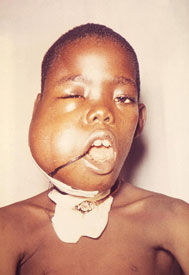Improving treatment of Burkitt's lymphoma and saving children's lives
November / December 2012 | Volume 11, Issue 6

Photo by Rober S. Craig/CDC
NIH-funded research recently revealed
Burkitt's lymphoma has a surprisingly
large number of genetic mutations, a
discovery that may speed treatment
for this aggressive cancer that hits
mainly African children.
Burkitt's lymphoma is a particularly cruel disease, hitting mostly children and developing aggressively. It is endemic in equatorial Africa, where chronic malaria helps weaken the immune system, and although chemotherapy can cure up to half of patients, many still die. So it was welcome news that an international team of scientists has unveiled some of the cancer's genetic secrets, making this form of non-Hodgkin's lymphoma easier to treat. Their findings were published recently in Nature.
Dr. Louis M. Staudt of the NIH's National Cancer Institute and his colleagues conducted genetic sequencing with high-capacity technology, which allowed them to quickly identify likely mutations that may cause the lymphoma. They found a surprisingly large amount of recurrent mutations compared with the number identified in other cancers. This opens many doors for improved understanding and potential treatments of Burkitt's lymphoma.
"Our job in cancer genomics is to divide cancer into precisely defined molecular categories," Staudt said. "That will enable a much more rapid understanding of essential pathways that could be responsive to drugs."
He noted that more effective treatments for Burkitt's lymphoma are needed especially in Africa. Patients there typically receive low-dose chemotherapy, rather than the high-dose therapies in the developed world where follow-up care is available for resulting infections. The low-dose regimen leaves a survival rate of below 50 percent. "That's way too low a rate," Dr. Staudt said. "So we hope that we might be able to supplement that minimal chemotherapy with some of these new targeted agents and improve the outcomes for patients there."
New therapies would also help the 15 percent of developed-world patients who are not treated adequately with current therapies, he noted. This includes the elderly, who are more vulnerable to infections after high-dose chemotherapy, even with ample supportive care.
More Information
To view Adobe PDF files,
download current, free accessible plug-ins from Adobe's website.